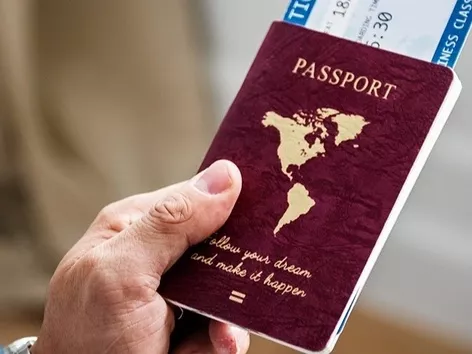Schengen area: history, features, countries are included 2023 and visa procedure
Table of contents
- The history of the creation of the Schengen zone
- Countries in schengen area
- Candidate countries for joining the Schengen area
- How does the Schengen area work?
- Visa for schengen area
- Types of Schengen visas
- List of documents for obtaining a tourist Schengen visa (category C)
- Prospects for the development of the Schengen area

The Schengen area is a space between EU countries where border controls at the internal border have been abolished. Find out more about which countries are part of the Schengen area, visa requirements and features
The Schengen zone is a space in which internal border control between states has been abolished. It includes 27 European countries. The Schengen zone in Europe operates according to the analogue of a single country, that is, border control is carried out at the external border - when entering or leaving the Schengen area, and there is no border and control at the internal borders between states.
Most of the member countries of the Schengen Agreement are members of the European Union, but they are two different areas.
What is the Schengen area? What are its features? But how to get a visa? Details in our material.
Expat City Ranking 2023: the best and worst cities for expats in the world - find here.
The history of the creation of the Schengen zone
In 1985, five countries: Belgium, Germany, Luxembourg, France and the Netherlands signed an agreement on visa-free travel and customs control in the city of Schengen. This is where the history of the Schengen zone began, and it got its name in honor of the city where the document was signed. Then the space gradually expanded, and other European countries joined it. Most of the states joined in the period from 1990 to 2011.
Countries in schengen area
The Schengen zone includes most of the EU countries: Australia, Denmark, Poland, Estonia, Greece, Italy, Latvia, etc., also included in Schengen, but not EU members are Iceland, Liechtenstein, Norway and Switzerland.
In addition to European countries, the zone includes Madeira, the Azores and the Canary Islands.
Andorra, the Vatican, San Marino and Monaco are not part of the Schengen area, but follow the rules of the space. You can enter the territory of these states on the basis of a Schengen visa, but only from the territory of a Schengen member state.
As of the beginning of 2023, Croatia became the last member of the Schengen zone, its application was approved in 2022.
There are also certain territories that belong to the Schengen area, but did not join the Schengen Agreement. To enter these countries, it is necessary to issue a visa for the given region: Greenland, Faroe Islands, Svalbard, Bear Island, Martinique, Mayotte, Reunion, Saint Barthelemy and Saint Maarten.
Candidate countries for joining the Schengen area
In the near future, Romania, Montenegro, Cyprus and Bulgaria are planning to become part of the Schengen visa-free zone. The exact date of accession of these states has not yet been determined, but foreigners have the right to travel to the countries on the basis of a Schengen visa.
How does the Schengen area work?
27 European countries undertook to observe the main rules of the zone:
- visa-free regime within the zone;
- unified rules of entry and exit from the territory of the Schengen zone and common visas;
- mutual exchange of information between the police and courts of the Schengen member states.
That is, citizens of the member countries of the Schengen zone can move through the territory of the member countries of the agreement without obtaining a visa, because there are no internal borders between the states.
Foreigners entering the territory of the zone must cross the border only once - upon entry. Countries work together to strengthen external borders. States also exchange information, for example, in the unified Visa Information System.
Visa for schengen area
A Schengen visa is a permit to enter the territory of the zone.
A foreigner issues a Schengen visa to the country through which he plans to enter the Schengen zone, passes border control and then moves freely between states. For example, you enter Poland, and then plan a trip to Germany and the Netherlands, in this case, the foreigner will pass control at the Polish border, and then go to other countries without hindrance.
Find out who needs a Luxembourg Schengen visa and how to apply for it here.
Types of Schengen visas
A – transit, operates exclusively in the transit zone of the airport;
B – transit through the Schengen countries (issued for a period of up to 5 days);
C – short-term, for travel, visiting relatives, participation in events or short-term residence in the Schengen area:
D – national Schengen visa, issued for work, study or long-term residence in a certain country and is valid only on the territory of the state that issued it. That is, you can live and work on the basis of an Italian Schengen visa only in Italy.
The most popular is the C visa. On its basis, you can stay in the territory of the Schengen zone for up to 90 days every 180 days. There are three types of permit: single (for a one-time entry into the Schengen area), double entry (you can enter the Schengen area twice) and multiple (unlimited number of entries during the validity period of the visa).
List of documents for obtaining a tourist Schengen visa (category C)
Foreign passport (valid for at least 3 months after the visa expires).
Visa application form.
Two photos 35×45 mm.
Medical insurance.
Confirmation of accommodation (reservation of hotels, hostels, etc.).
Confirmation of financial support - bank statements.
A return ticket or other confirmation that the applicant does not plan to stay in the Schengen area.
Also, when applying for a Schengen visa, it is necessary to provide the applicant's biometric data: digital photos and fingerprints. This procedure is carried out every five years.
You can apply for a visa at the consulate or visa center of a country that is a member of the Schengen Agreement. If you have a planned tour of several countries that are members of the agreement, then apply for a visa at the consulate of the country in which you plan to spend the largest number of days.
The application review period is up to 45 days. The size of the consular fee depends on the nationality of the applicant, the type of visa and a number of other factors.
Prospects for the development of the Schengen area
Experts predict that the Schengen zone will continue to expand in the future.
To control the entry and exit of citizens of third countries, the European Union plans to launch the EES system. It is also planned that by the end of 2023, citizens of countries that previously entered the Schengen area on the basis of a visa-free visa will have to have an ETIAS permit to enter European countries.
Products from Visit World for a comfortable trip:
Medical insurance all over the world;
Legal advice from a local specialist on visa and migration issues (to receive the service, select the country of interest and citizenship).
Recommended articles
1 min
Expats
Expat life in Italy: what difficulties do foreigners face when moving in 2025
Moving to Italy is an opportunity to discover a new quality of life amidst culture, sun and gastronomic delights, but it also comes with its own challenges. Find out what challenges expats in Italy will face in 2025 and how to prepare for them
29 Jun. 2025
More details1 min
Travels
Holidays in Egypt in 2025: the most popular destinations and what tourists should visit
Planning a trip and want to choose the perfect vacation destination? Find out why Egypt remains one of the most popular travel destinations in the world: from the pyramids of Giza and Luxor to Red Sea resorts and desert oases
21 Sep. 2025
More details3 min
Travels
Best Countries to Visit with Kids in 2023
When travelling with children, you need to take care of all the nuances of your holiday. Find out more about family holidays and the top 10 countries for travelling with children
01 Jun. 2023
More details3 min
Expats
More than 120 modern countries allow their residents to hold dual citizenship. This status provides many advantages, including the removal of visa restrictions, tax benefits for businesses, and employment opportunities. Find out more about which countries are the easiest to obtain dual citizenship in 2024 and which countries prohibit having a second passport
19 Aug. 2024
More detailsAll materials and articles are owned by VisitWorld.Today and are protected by international intellectual property regulations. When using materials, approval from VisitWorld.Today is required.
